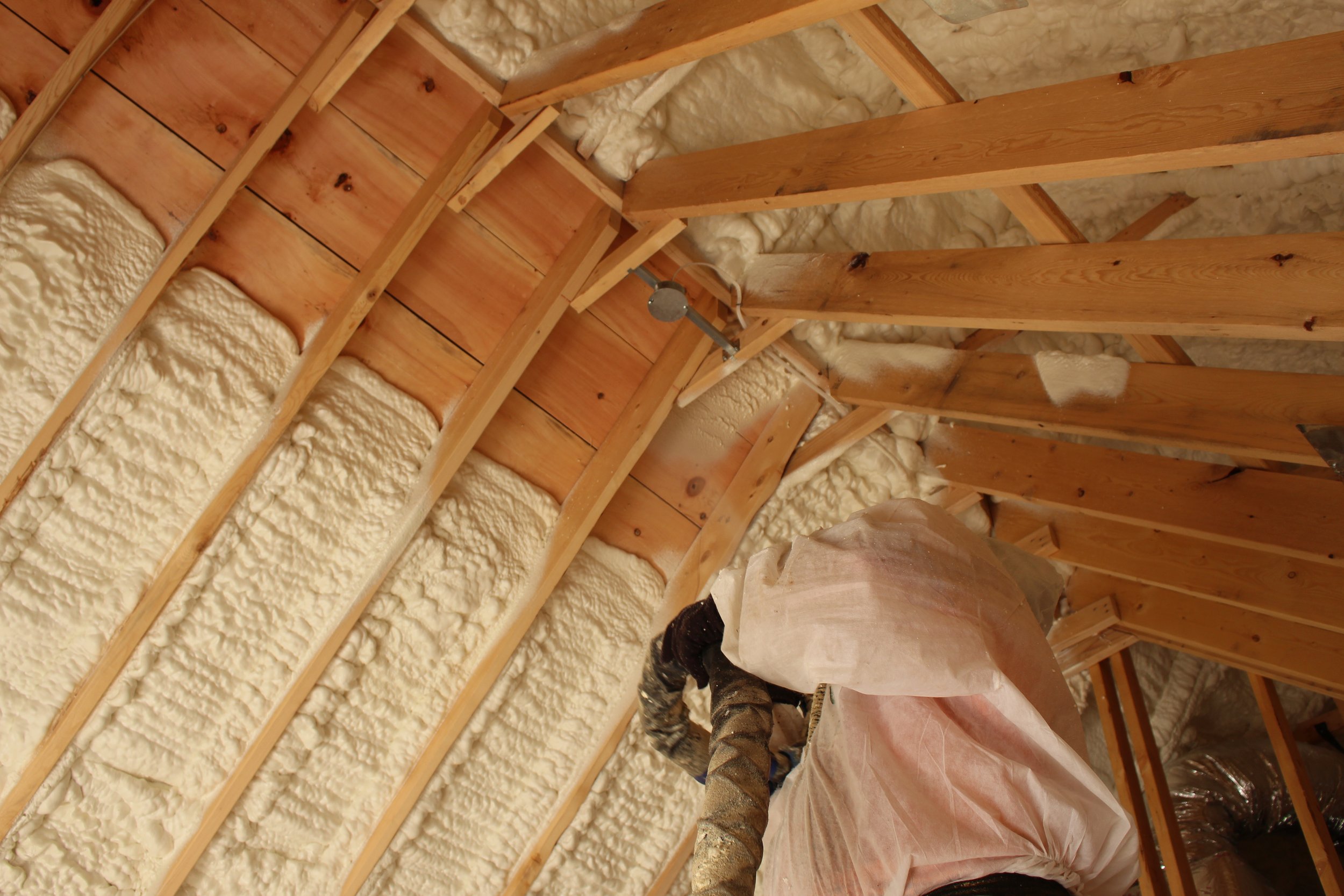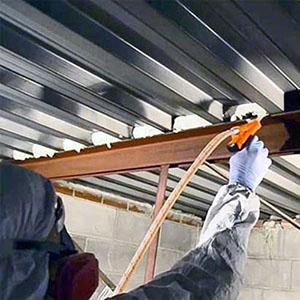Choosing the Right Kind Of Spray Foam for Your Insulation Requirements
Choosing the Right Kind Of Spray Foam for Your Insulation Requirements
Blog Article
Spray Foam: The Ultimate Remedy for Air Sealing and Insulation
Spray foam insulation has become a leading option for efficient air sealing and thermal insulation, using a distinct combination of homes that set it besides typical approaches. Its capability to increase and load voids makes it particularly efficient in protecting against air leak, which can significantly influence power effectiveness. Understanding the complete range of its benefits, installment procedures, and contrasts with various other insulation types is critical for making notified decisions. As we check out these facets, the implications for both brand-new buildings and retrofits become progressively substantial. What variables should influence your choice?
What Is Spray Foam?
Spray foam is a versatile insulation product that incorporates the principles of air securing and thermal resistance to enhance energy efficiency in buildings. Made up largely of polyurethane or other comparable substances, spray foam is applied as a fluid that expands upon contact with surfaces, creating a strong, continuous layer of insulation. This distinct residential or commercial property allows it to load gaps, cracks, and spaces that conventional insulation products might forget, offering an exceptional air seal.
There are 2 main kinds of spray foam: open-cell and closed-cell. Open-cell spray foam is lighter and much more adaptable, using excellent sound absorption and a lower R-value per inch - Spray Foam. In contrast, closed-cell spray foam is denser, supplying a higher R-value, moisture resistance, and included architectural honesty to constructing components
The application process generally entails specialized equipment, making sure a seamless application that complies with different substrates, consisting of wood, metal, and concrete. This adaptability makes spray foam suitable for both new building and constructions and retrofitting existing frameworks. Its capacity to produce an impermeable barrier significantly adds to reducing energy consumption and boosting indoor air top quality, thus making it a preferred option among homeowners and contractors alike.
Advantages of Spray Foam Insulation
One of the most significant advantages of spray foam insulation is its remarkable capacity to develop a constant air obstacle, which successfully reduces energy loss. Unlike standard insulation materials, spray foam expands to fill gaps and splits, guaranteeing that air leakage is dramatically minimized. This particular not just improves power effectiveness however likewise results in reduce energy costs over time.
Additionally, spray foam insulation provides exceptional thermal resistance, adding to a more steady indoor atmosphere. Its high R-value per inch allows for effective insulation in restricted areas, making it suitable for attics, walls, and crawl spaces. The moisture-resistant properties of spray foam aid avoid mold and mildew development, promoting much healthier living conditions.
Another crucial advantage of spray foam insulation is its sound-dampening top qualities (Spray Foam). It efficiently reduces noise transmission between spaces, developing a quieter and a lot more comfy home environment. The durability of spray foam additionally stands apart, as it does not sag or work out in time, keeping its performance throughout its life expectancy
Exactly How Spray Foam Functions
Recognizing how spray foam insulation functions is important for valuing its performance in air sealing and thermal resistance. Spray foam insulation contains 2 key elements: isocyanate and polyol resin. When these elements are mixed, they go through a chain reaction that creates the product to broaden swiftly, developing a thick foam that fills up spaces, cracks, and dental caries.
As the foam expands, it complies with surfaces, forming a closed seal that dramatically decreases air seepage. This characteristic makes spray foam insulation extremely reliable at protecting against drafts and dampness penetration, which can result in energy loss and damage gradually. In addition, the closed-cell variation of spray foam uses exceptional thermal resistance as a result of its stiff structure, successfully minimizing warmth transfer.
The one-of-a-kind homes of spray foam allow it to adapt to irregular surface areas, guaranteeing detailed insurance coverage and a seamless barrier. Because of this, spray foam insulation not only enhances energy efficiency but additionally adds to improved Learn More indoor air quality by minimizing the accumulation of pollutants and irritants. Ultimately, comprehending the mechanics behind spray foam underscores its function as an exceptional option for insulation and air sealing in both commercial and property applications.
Installment Refine Review

Prior to installation, the area has to be adequately cleaned and prepped, guaranteeing that surfaces are without dampness, particles, and dust. This step is crucial due to the fact that pollutants can endanger attachment and general efficiency. As soon as the location is prepared, the application entails blending both components of the spray foam, which broadens upon contact and fills up voids efficiently.
Educated professionals should conduct the setup, making use of customized equipment to make sure consistent insurance coverage and optimum thickness. Safety safety measures, including using protective equipment and making sure correct air flow, are imperative throughout this process. After application, the foam normally treatments promptly, forming a solid obstacle that improves energy efficiency.
Comparing Spray Foam to Typical Insulation
When evaluating insulation choices, spray foam insulation stands out in comparison to standard products such as fiberglass and cellulose. Unlike fiberglass and cellulose, which can allow air infiltration, spray foam expands upon application, filling up holes and spaces to develop a closed seal.
Furthermore, spray foam gives a higher R-value per inch than conventional insulation types, providing more reliable thermal resistance in a thinner profile. This particular is especially beneficial precede with restricted dental caries deepness. Spray foam is immune to moisture and mold growth, which can be a considerable problem with cellulose and fiberglass, especially in humid settings.
However, spray foam insulation typically lugs a higher upfront cost than its standard counterparts. House owners should evaluate this initial financial investment versus lasting power savings and performance advantages. Inevitably, while both insulation types serve their objective, spray foam arises as an advanced service for modern-day insulation demands, particularly in terms of air sealing have a peek at this website and thermal performance.

Conclusion
In summary, spray foam insulation stands for a very reliable solution for attaining ideal air sealing and thermal resistance. Its distinct buildings, including wetness resistance and noise dampening, make it ideal for numerous applications in both brand-new building and constructions and retrofitting jobs (Spray Foam). Although the first expenses might be higher compared to standard insulation materials, the long-lasting advantages, such as significant power savings and improved indoor air quality, validate the financial investment and highlight its value in contemporary straight from the source structure practices.
Spray foam insulation has emerged as a leading remedy for efficient air sealing and thermal insulation, using an unique combination of properties that establish it apart from traditional techniques.Spray foam is a flexible insulation material that integrates the principles of air securing and thermal resistance to enhance energy performance in structures.When reviewing insulation choices, spray foam insulation stands out in contrast to conventional products such as fiberglass and cellulose. Inevitably, while both insulation types offer their function, spray foam emerges as a much more advanced service for modern-day insulation requirements, especially in terms of air sealing and thermal performance.
In summary, spray foam insulation represents a highly effective option for achieving ideal air sealing and thermal resistance.
Report this page